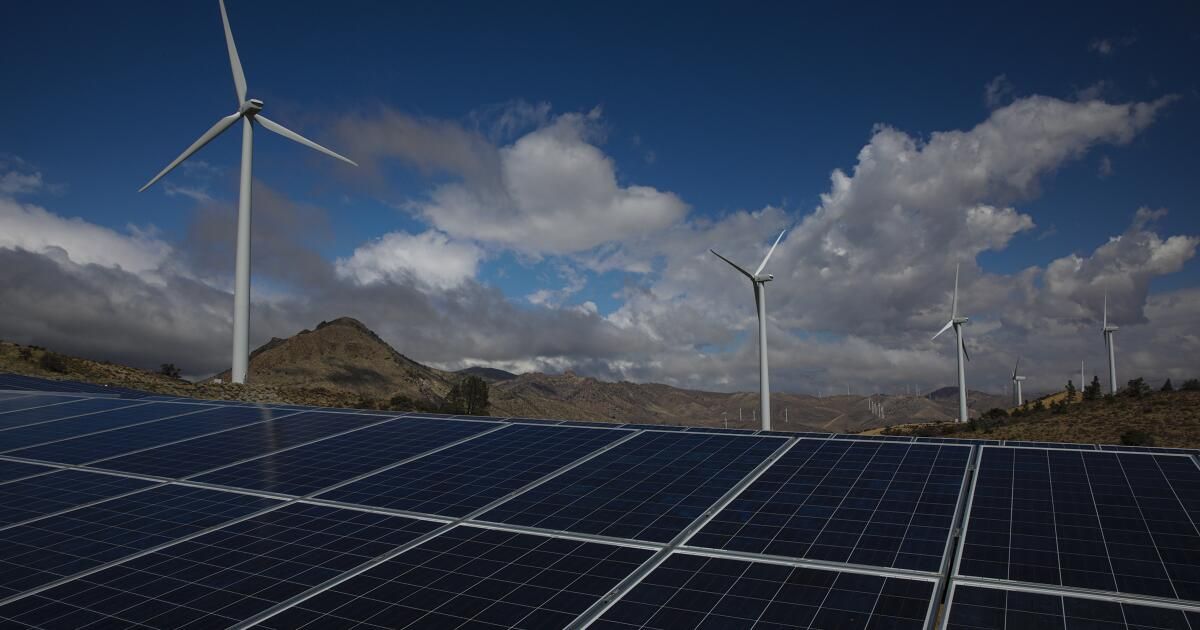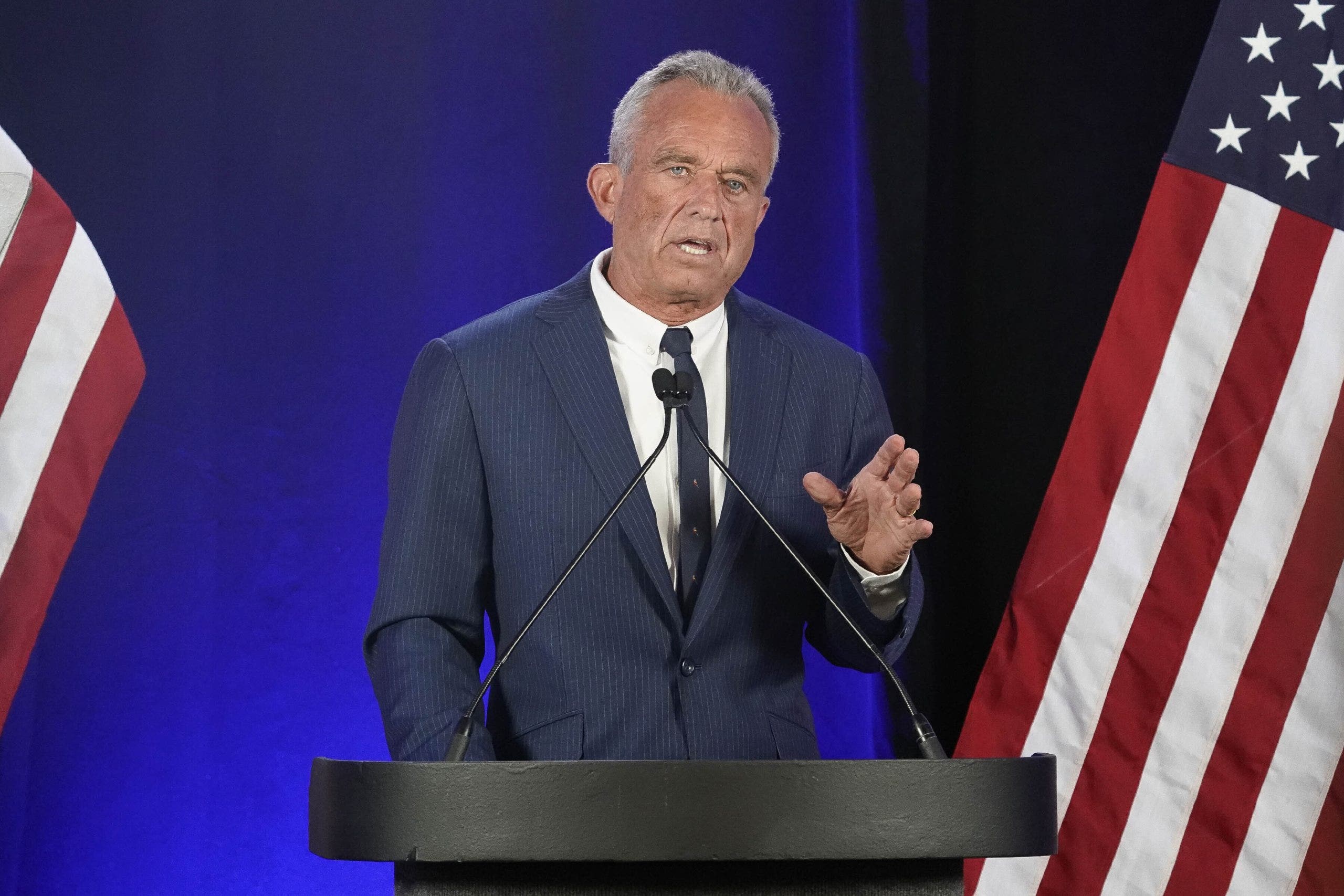Wind turbines rise atop a series of solar panels at the Los Angeles Department of Water and Power's wind farm and solar power plant in Kern County's Tehachapi Mountains.
(Irfan Khan/Los Angeles Times)
California is on the verge of missing its ambitious greenhouse gas reduction goals by the end of the decade unless it can triple its efforts to reduce carbon emissions statewide, according to a critical new report.
Although the state has pledged to reduce planet-warming emissions by 40% of 1990 levels by 2030, it is not on track to meet that commitment, according to an analysis by the nonprofit group Next 10 and Beacon Economics. a consulting firm based in Los Angeles. .
According to the most recent data available from the state, emissions have fallen just 11.5% below 1990 levels.
“Policymakers have set this goal and now need to make difficult decisions about trade-offs if they want to achieve it,” said Stafford Nichols, research manager at Beacon.
While pollution plummeted after stay-at-home orders were issued during the pandemic in 2020, the state's carbon emissions rose 3.4% the following year, according to the analysis.
That will make it more difficult to meet the goal set by state lawmakers in a 2016 bill known as SB 32.
According to the report's authors, based on the trajectory of reductions since 2010, California will not reach the mandatory goal until 2047.
The 2021 emissions increase was driven by an increase in electric power generation, according to the report. Because of the drought that year, the state used less hydroelectric power and compensated with more power from natural gas-fired power plants, Nichols said.
That year also saw a 7.4% increase in emissions from transportation as pandemic restrictions eased. Not only did Californians get back into their cars in 2021, but more people avoided public transportation. Researchers found that ridership in 2022 was 40% lower than before the pandemic, slowing the state's progress in reducing passenger vehicle emissions.
The report, called the California Green Innovation Index, provides an annual snapshot of the state's decarbonization efforts. Nichols said researchers had been frustrated that state officials took longer to release emissions data. The 2021 numbers were released just a couple of months ago, he said.
He said calculations using more recent data would likely result in an even faster pace of carbon reductions being needed to meet the 2030 target.
The chairwoman of the California Air Resources Board, the agency charged with overseeing greenhouse gas reductions, disagrees with the study's conclusion and insists that California is on track to meet its goals.
“Our preliminary data shows that in 2022 emissions began to decline,” said Liane Randolph, who was appointed to lead the board by Governor Gavin Newsom.
Randolph noted that although California's economy recovered 8% in 2021, emissions increased only 3.4%.
“To me, that shows that our programs are working,” he said. “This shows that we are not only growing our economy, but we are also developing a fundamentally cleaner economy.”
Newsom spokesman Alex Stack added: “We don't shy away from ambitious goals, because that's what it takes to make a difference. “Our administration and CARB are taking the necessary actions to achieve these goals.”
Details in the new report show how far the state has yet to go. Researchers calculated that the state had reduced emissions on average 1.5% annually between 2010 and 2021. To meet the 2030 goal it would now have to reduce emissions by 4.6% annually.
California has only reduced emissions by more than 4% annually twice in the last two decades, and both years (2009 and 2020) were times of economic recession.
Despite the report's forecast, the authors acknowledged that California is the third most carbon-efficient state, after New York and Massachusetts. California's carbon intensity is 8.8% lower than the national average, according to the report.
And while emissions from electricity production increased in 2021, they have still decreased more than 40% since 2000 and 12% since 2016.
The state also met its 2025 goal of having 1.5 million zero-emission vehicles on the road two years early, although electric vehicle sales fell for the first time in more than a decade at the end of last year.
“While California is well positioned as a leader on climate, there are substantial obstacles to accelerating our decarbonization efforts in an equitable way that benefits all Californians,” said F. Noel Perry, founder of Next 10. “These issues are not insurmountable, but we must act urgently.
The researchers highlighted how California could eliminate emissions by finding ways to decarbonize the state's cement factories. That industry represents 2% of the state's emissions. Greenhouse gases from the eight plants that produced almost all of the state's cement increased 26% between 2011 and 2021.
While California plants are marginally more efficient than the average American cement factory, they emit about 33% more pollutants than those in China and India, according to the report.
The new report was not the first to detail how the state was falling short of its climate goals.
in a report published last year, the nonpartisan Legislative Analyst's Office, which advises state lawmakers, estimated that emissions had been falling on average about 1% annually over the past decade and would need to fall 4% annually. That report said the California Air Resources Board lacked “a clear strategy” to meet the 2030 goal.
The agency's “estimated reductions are driven primarily by assumptions developed by CARB, without specifying how those assumed results could be achieved,” that report said.
Newsletter
Towards a more sustainable California
Get Boiling Point, our newsletter exploring climate change, energy and the environment, and be part of the conversation and the solution.
You may occasionally receive promotional content from the Los Angeles Times.












